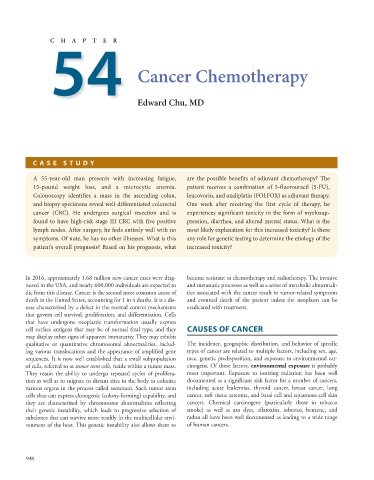Page 962 - Basic _ Clinical Pharmacology ( PDFDrive )
P. 962
54 Cancer Chemotherapy
C H A P T E R
Edward Chu, MD
C ASE STUD Y
A 55-year-old man presents with increasing fatigue, are the possible benefits of adjuvant chemotherapy? The
15-pound weight loss, and a microcytic anemia. patient receives a combination of 5-fluorouracil (5-FU),
Colonoscopy identifies a mass in the ascending colon, leucovorin, and oxaliplatin (FOLFOX) as adjuvant therapy.
and biopsy specimens reveal well-differentiated colorectal One week after receiving the first cycle of therapy, he
cancer (CRC). He undergoes surgical resection and is experiences significant toxicity in the form of myelosup-
found to have high-risk stage III CRC with five positive pression, diarrhea, and altered mental status. What is the
lymph nodes. After surgery, he feels entirely well with no most likely explanation for this increased toxicity? Is there
symptoms. Of note, he has no other illnesses. What is this any role for genetic testing to determine the etiology of the
patient’s overall prognosis? Based on his prognosis, what increased toxicity?
In 2016, approximately 1.68 million new cancer cases were diag- become resistant to chemotherapy and radiotherapy. The invasive
nosed in the USA, and nearly 600,000 individuals are expected to and metastatic processes as well as a series of metabolic abnormali-
die from this disease. Cancer is the second most common cause of ties associated with the cancer result in tumor-related symptoms
death in the United States, accounting for 1 in 4 deaths. It is a dis- and eventual death of the patient unless the neoplasm can be
ease characterized by a defect in the normal control mechanisms eradicated with treatment.
that govern cell survival, proliferation, and differentiation. Cells
that have undergone neoplastic transformation usually express
cell surface antigens that may be of normal fetal type, and they CAUSES OF CANCER
may display other signs of apparent immaturity. They may exhibit
qualitative or quantitative chromosomal abnormalities, includ- The incidence, geographic distribution, and behavior of specific
ing various translocations and the appearance of amplified gene types of cancer are related to multiple factors, including sex, age,
sequences. It is now well established that a small subpopulation race, genetic predisposition, and exposure to environmental car-
of cells, referred to as tumor stem cells, reside within a tumor mass. cinogens. Of these factors, environmental exposure is probably
They retain the ability to undergo repeated cycles of prolifera- most important. Exposure to ionizing radiation has been well
tion as well as to migrate to distant sites in the body to colonize documented as a significant risk factor for a number of cancers,
various organs in the process called metastasis. Such tumor stem including acute leukemias, thyroid cancer, breast cancer, lung
cells thus can express clonogenic (colony-forming) capability, and cancer, soft tissue sarcoma, and basal cell and squamous cell skin
they are characterized by chromosome abnormalities reflecting cancers. Chemical carcinogens (particularly those in tobacco
their genetic instability, which leads to progressive selection of smoke) as well as azo dyes, aflatoxins, asbestos, benzene, and
subclones that can survive more readily in the multicellular envi- radon all have been well documented as leading to a wide range
ronment of the host. This genetic instability also allows them to of human cancers.
948

